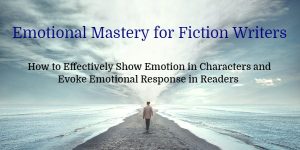Evoking Emotions in Readers in a Masterful Way – Part 2
We’ve been delving into the challenge of the emotional concerns in fiction writing. It’s a twofold objective: showing characters who experience emotions, in order to make them believable in all their natural human behavior, and evoking emotion in our readers, which is, I believe, the harder of the two tasks.
However, to be a masterful writer, we must master both. It doesn’t take a lot of work to learn how to “show” emotion in our characters, though the tendency might be to drift into tropes and boring actions (her heart pounded in her chest; he clenched his fists and gritted his teeth). Granted, sometimes we are hard pressed to be masterfully original with every bit of emotional showing we do (though, as we saw in the posts on masterful description, “fresh” and “original” can be achieved with effort).
We’ve seen, to a limited extent, how characters can effectively “tell” their emotions, share what they are feeling, and that can be done quite masterfully as well.
And that leads to the issue we discussed in the last post on the subject: how to manipulate readers’ emotions.
To reiterate a key point: thoughts lead to feelings. For example: I start to think how I might have accidentally left the back door open, and that might have been why my toddler wandered out of the house and is now lost. That thought induces emotions of guilt and self-recrimination. A thought comes into my head, suggesting my boyfriend may have lied about where he was last night, and suddenly I am suspicious, doubting him, wondering if he is cheating on me, and that last thought detonates feelings of anger and betrayal.
Thoughts spark emotions. So when we show what our characters are thinking, via the narrative or direct thoughts (when in their POV), and even in dialogue (whether in the POV or not), we can sense what they might be feeling. Sometimes the feelings are obvious, but masterful writing will imply the complexity of the character’s emotions.
As I discussed in the last post, when we go for the obvious big emotions (showing our character mad, sad, or glad), they can come across flat, boring, shallow, and, worst of all, not evoke any emotion at all in our readers.
More than anything, we want to manipulate our readers’ feelings, and we do this with surprise, with the unspoken, with subtext. Sure, a character can say or think “I’m so angry. I’m furious. I want to kill him!” and it can be done in a way that’s boring or a way that’s masterful. What can take the boring into the masterful arena is by complicating the emotion.
If the reader senses more beneath the anger. If she can feel the hurt, for example, it has a different effect on the reader than if the only emotion seen or felt is anger.
We’ve been taught that “showing” is better than telling, but showing a person throwing a chair might imply anger, but it won’t necessarily explain the impetus behind the anger. It won’t make readers feel angry either. Or compassion, if that’s the objective.
But if we see actions implying an emotion, and we hear thoughts (which can be the running narrative, since all lines in a scene are the POV character’s thoughts, essentially, regardless of whether you’re in first-person or third-person POV) that indicate the reason for the action (implying emotion), we start to work toward evoking emotion in the reader.
You Need to Know Where You’re Going
But we must know what emotion(s) we want to evoke. And sometimes that isn’t easy to put into simple terms. Sometimes when I write scenes, I know how I want my reader to feel, but I don’t think I could easily articulate it. However, I know what that desired emotion feels like inside me. I know what kinds of things (words, actions, events) trigger those emotions in me. And so I attempt to create situations and thoughts for my characters that evoke the emotions I’m going for.
Remember Hemingway’s advice: “Find what gave you the emotion . . . then write it down, making it clear so the reader will see it too and have the same feeling as you had.”
Work on the Microtension
We want tension on every page. Microtension is created when things feel off, feel contradictory, seem puzzling. We want our readers in a constant state of unease, stress, discomfort.
Maybe that sounds crazy, but if characters are sitting around happy with nothing bothering them, we have a boring scene that readers will stop reading. Sure, at the end of your book, you might have that wonderful happy moment when it’s all wrapped up and the future, finally, looks bright (or at least better than it has looked recently), but that’s why the book ends there. The story, for the moment, is over (unless you deliberately leaves tension hanging so readers will jump into the next book in the series to relieve that tension).
When you read passages in novels that evoke emotion in you, tear apart the lines and figure out why they work. Examine how you are feeling, what you are feeling, what your thoughts are that are sparking those feelings. Sometimes when you read something, it triggers memories and associations, and it’s those things that cause the emotions to well up.
Remember, when you tap into universal feelings—human experiences many or most share—the thoughts and actions of a character will resonate. And when something resonates, such as in music when a sound wave causes a string to vibrate, it elicits a response. Readers don’t just read, says Donald Maass, they respond.
Next week, I’ll start giving some passage examples to show how characters’ thoughts lead to readers experiencing emotion.
Any thoughts on these observations?
Want to master the emotional craft of fiction?
Dive into the online course Emotional Mastery for Fiction Writers!
In this course, you’ll be given tools to show emotions in your characters. You’ll be given techniques to help spark emotional response in your readers. What is going to bring it all together for you is practice. Study and practice. And you’ll have exercises in this course to help you put into practice what you learn.
There are two facets of emotion in fiction: conveying what your character is feeling and evoking emotion in your reader. We’ll look at these two facets separately and in de pth. Yet, they are intrinsically connected.
pth. Yet, they are intrinsically connected.
Emotional mastery requires writers to set up the dynamics of a scene in such a visual, textural way that readers can’t help but feel what they are meant to feel. Understanding that emotional mastery requires a twofold approach—the emotional landscape of both the character and the reader—is the first step.
Want to learn how to become a masterful wielder of emotion in your fiction? Enroll in my new online video course, Emotional Mastery for Fiction Writers.
You’ll get lifetime access to all the videos and more than three dozen downloadable assignments. And with a 30-day money-back guarantee, you have NOTHING to lose by jumping in. Sign up NOW.
This course will challenge you to become an “emotion master.” Are you ready and willing to go on this journey deep into emotional territory? If you want your characters to move your readers, take the plunge!












I totally believe thoughts lead to emotions. It’s like if you have a rotten day and you keep thinking about all the things that went wrong, you’ll get all upset. But if you remember all the nice things people did to help you out, you feel kind of peppy despite the rotten day. I’m looking forward to next week’s post!
Writers: we need our characters’ emotions to resonate with our readers. Find tips here.
Great tips as usual. Love the Hemingway quote. Emotions can be individual, but we all have them. The specifics are in the details. I’ve shared the post online. Thanks for all you do to assist your fellow writers. All best to you.
http://victoriamarielees.blogspot.com